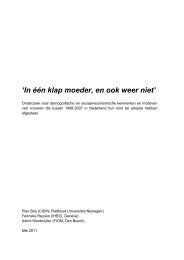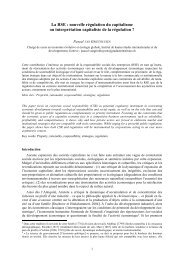PDF - Graduate Institute of International and Development Studies
PDF - Graduate Institute of International and Development Studies
PDF - Graduate Institute of International and Development Studies
You also want an ePaper? Increase the reach of your titles
YUMPU automatically turns print PDFs into web optimized ePapers that Google loves.
In Abu Dhabi research in the field <strong>of</strong> solar energy is again led by Masdar. In May<br />
2008, Masdar invested in a new company, Masdar PV, in Erfurt, Germany. Masdar PV is<br />
constructing a thin-film photovoltaic (PV) manufacturing facility, which is expected to<br />
produce more affordable panels. A similar facility will also be created in Abu Dhabi.<br />
Masdar also invests in thermal solar energy, based on concentrators (mirrors) <strong>of</strong><br />
various shapes. It has established Torresol Energy, a joint venture between Masdar <strong>and</strong><br />
the Spanish engineering group Sener, which has three solar power plants under<br />
construction in Spain with an approximate combined investment cost <strong>of</strong> $800 million. It<br />
also has a project for concentrated solar power (CSP) in Abu Dhabi, called Shams 1: a<br />
tender has been issued to invite companies to participate in this project, but the original<br />
deadline was later delayed, <strong>and</strong> no firm progress has been made at the time <strong>of</strong> writing.<br />
Saudi Arabia <strong>and</strong> Abu Dhabi have been the most active among the GCC countries<br />
in the field <strong>of</strong> solar energy, although smaller initiatives are also registered in the rest <strong>of</strong><br />
the group. 10 One Bahraini expert 11 has estimated that Bahrain alone will have to invest an<br />
estimated $900 million in wind <strong>and</strong> solar power in the next decade to meet the growing<br />
dem<strong>and</strong> for energy. Similarly, he estimated that Kuwait would need to spend $2.5 billion<br />
(BD 945 million), Oman $800 million (BD 302 million), Qatar $600 million (BD 226.8<br />
million), Saudi Arabia $15 billion (BD 5.67 billion) <strong>and</strong> the UAE $5.1 billion (BD 1.9<br />
billion). Against this investment new solar <strong>and</strong> wind electricity may reach 5 GW by 2015<br />
(a minuscule contribution: Saudi Arabia alone consumed 160 GW in 2004 …).<br />
Clearly, actual progress in the direction <strong>of</strong> implementing major solar energy<br />
projects will be conditional on further decreases in the cost <strong>of</strong> the required equipment.<br />
One notes that the Gulf countries are pragmatically leveraging their financial resources to<br />
engage in international scientific cooperation <strong>and</strong> ‘import’ the best available technology,<br />
with a very long-term approach. They expect eventually to be able to reap the benefit<br />
because <strong>of</strong> favourable local conditions, also with respect to the production <strong>of</strong> the required<br />
equipment (photovoltaic panels).<br />
In a recent study, Yasser Al-Saleh, Paul Upham <strong>and</strong> Khaleel Malik have explored<br />
several renewable energy scenarios for Saudi Arabia, based on a Delphi panel <strong>of</strong> thirty-<br />
10 For a detailed analysis <strong>of</strong> these initiatives see EPU-NTUA 2009.<br />
11 Pr<strong>of</strong>essor Waheeb Alnaser, chairman <strong>of</strong> the Bahrain chapter <strong>of</strong> the <strong>International</strong> Solar Energy Society<br />
(ISES), speaking at a conference organized by UNIDO in Bahrain in February 2009.<br />
13




